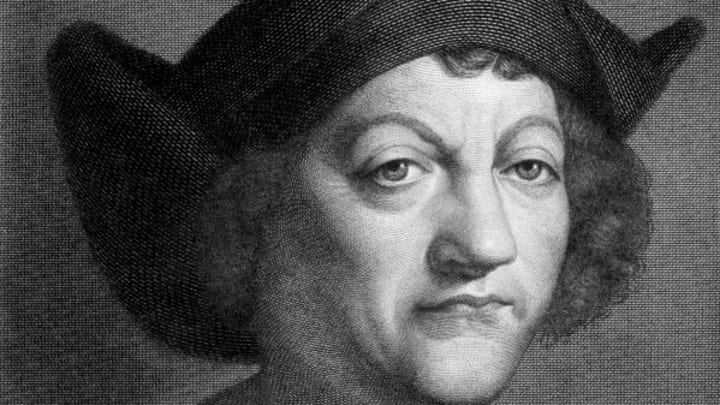SCIENTISTS (1451–1506); GENOA, ITALY
Most people who went to elementary school in the United States know the name Christopher Columbus. Born Cristoforo Colombo, he's one of history's most famous explorers, but his accomplishments and legacy are hotly disputed today. Christopher Columbus may not have discovered America, but he did take several voyages to the continent that helped ignite Europe’s Age of Exploration. And while he's celebrated for his achievements in some circles, he's vilified in others, due to his mistreatment of indigenous populations and even his own crew. Find out more about the complicated life of Christopher Columbus.
1. Most historians believe Christopher Columbus was born in Genoa, Italy.

According to the consensus among historians, Christopher Columbus was born in the Republic of Genoa (or Genova) in what would later become Italy. The exact date of his birth is unknown, but it’s estimated he was born sometime in 1451. It’s possible that his mother was Susanna Fontanarossa and his father was a wool merchant named Domenico Colombo.
2. There's also the theory that Christopher Columbus was from Portugal.

Italians have long claimed Christopher Columbus as one of their own, but not everyone is in agreement about the explorer’s birthplace. In 2012, University of Lisbon professor Fernando Branco published a book proposing that Columbus was actually born in Portugal. The theory states that Columbus was really a man named Pedro Ataíde and his more famous identity was a cover. Pedro Ataíde allegedly died during a naval battle in 1476, but Branco postulates that he survived and washed up on the shores of the Algarve in Southern Portugal. One of the first historical records of Columbus describes him swimming away from a shipwreck. Much of the evidence Branco presents can be chalked up to coincidence, but the theory does highlight the fact that many details are missing from historical records of Columbus’s early life.
3. Christopher Columbus's voyage to America started from Spain, not Italy.

To make the question of his ethnicity even more confusing, Christopher Columbus didn’t take his famous voyage under the flags of Italy or Portugal. In the late 15th century, Columbus hatched a plan to chart a passage to the East Indies by sailing West instead of East. If his trip was successful, the profits he’d gain through an alternative spice trading route could make him rich—but he still needed funds to get a ship out of the dock. Queen Isabella I of Castile and King Ferdinand II of Aragon ultimately agreed to sponsor his journey, and in August 1492, he led the Pinta, the Niña, and the Santa Maria out of the port of Palos in Spain and into the New World.
4. The ships Christopher Columbus used to sail to America were a nightmare.

The two smaller boats that made up Christopher Columbus's fleet—the Niña and the Pinta (which were nicknames, not official names)—were state-of-the-art caravels. These vessels were known for their aerodynamic sails and lightweight build that made them fast and easy to navigate. They were also famously uncomfortable. The one cabin at the back of the ship was reserved for its captain, and the rest of the 20 to 30 crew members had to sleep on the cramped deck—that is, if they could ever stop working long enough to actually rest for a moment. The situation was slightly better on the larger Santa Maria, where there were cabins for both Columbus and his crew. Even so, the sailors were close to mutiny by the time the fleet reached the Bahamas following roughly two months at sea.
5. Christopher Columbus wasn’t the first European to discover North America.

For centuries, Christopher Columbus has been erroneously credited with discovering North America—a continent where human civilization had already been flourishing for thousands of years. But even his title as the first European to travel to the Americas is inaccurate. Viking explorer Leif Erikson beat Columbus by about 500 years, likely landing in Newfoundland, Canada, around 1000 CE. Some legends even suggest that Irish monks traveled to Canada by the North Sea before either explorer set sail.
6. Christopher Columbus’s voyage in 1492 wasn’t his only trip to North America.

Following his initial contact with the Americas in 1492, Columbus made a few return trips. He was back in Spain for less than a year when he boarded a ship in September 1493 and crossed the Atlantic a second time. There was a five-year gap between this trip and his third journey to North America in 1498, which eventually involved him being arrested for his mismanagement and cruelty during the whole fiasco.
His fourth and final voyage to the Caribbean took place in 1502. Columbus never found China or India or the gold he was looking for, but he did manage to terrorize and enslave native islanders, turn his crews against him (feeding them worm-infested biscuits will do that), and get stranded in Jamaica for a year after wrecking a four-boat fleet. Christopher Columbus would die on May 20, 1506.
7. Columbus Day became a federal holiday in 1937—but not everyone is a fan.

In 1937, President Franklin Delano Roosevelt declared October 12 as Columbus Day, a federal day of observance that became a reality thanks to the influence of a Catholic group called the Knights of Columbus. In 1971, President Richard Nixon created the modern version of Columbus Day by declaring that it be observed on the second Monday of every October. This was in an attempt to make uniform holidays that took place on Mondays to create more three-day weekends for Americans.
That doesn't mean everyone is a fan of the holiday. Due to Columbus's malicious treatment of Native Americans and other indigenous people, many states and cities refuse to recognize Columbus Day, instead opting for Indigenous Peoples' Day, while others celebrate Leif Erikson Day to honor the traveling Norseman.
